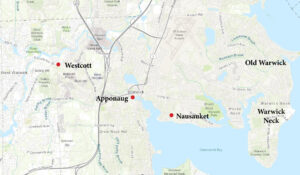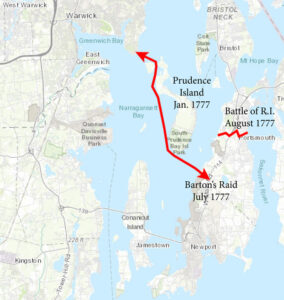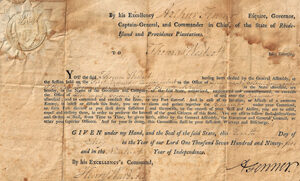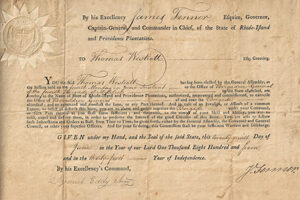By David Wescott Smith, SSWDA Historian
(This is an update to an article prepared in 2018 for the Westcott Family Quarterly to include recently received original documents.)
When I heard about the burial lot in Westcott, Rhode Island named after “General Thomas Westcott of Revolutionary War fame,” I thought it would be great to crow about a Westcott cousin who was a heroic Revolutionary War general, one to offset the unfortunate turn of cousin Benedict Arnold. What I did learn is that tucked between the family stories and the historical record is that Westcott was not a general during the War of Independence (and might not be buried in the lot named after him), but Thomas Westcott was a cousin who served often and served well.
The real Thomas Westcott was born on July 16, 1758 in Warwick, Rhode Island to Nathan and Mary (Rutenburg) Westcott. He was the great grandson of Stukely Westcott (Thomas5, Nathan4, Josiah3, Jeremiah2, Stukely1). He married Marcy Arnold on February 4, 1781. (No, Marcy Arnold was not a descendant of Governor Benedict Arnold and Damaris Westcott; she was the great-great-granddaughter of the Governor’s brother Stephen and a fourth cousin of General Benedict Arnold.)
Thomas and Marcy had eleven children. After Marcy died on May 5, 1810, Thomas married Elizabeth Low (May 21, 1777 to April 6, 1858). Thomas and Elizabeth did not have children. Thomas died on September 22, 1838 and was buried in the Marble Lot in the Nausauket section of Warwick. His gravestone was later moved four miles to the west and placed in the General Thomas Westcott Lot in what is now the village of Westcott in West Warwick, R.I. (Whether his remains went with the stone is not known.) All of this is from Edna Lewis, The Westcott Family Tree. There is not much more information in The Westcott Family Tree about Thomas’ descendants beyond the eleven children.
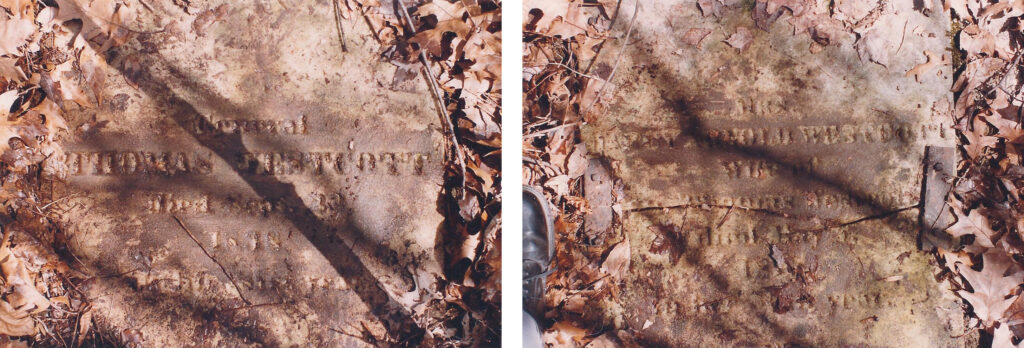
Head stones of Thomas Westcott (left) and his first wife Mary Arnold Westcott in the General Westcott Lot (Rhode Island Historical Cemetery Warwick #125) in Westcott, R.I.
It appears that Thomas spent all or most of his life in Nausauket, a farming and shipping area on the Greenwich Bay just to the east of Apponaug Cove. It was also at Nausauket and neighboring Old Warwick that Thomas began his military career and rise to general. The family story is picked up in a 1984 newspaper article: “General Westcott is the one who gathered the forces to defend Nausauket and Old Warwick. This was shortly after Major {sic} William Barton and his men made a bold raid on Middletown, captured the British Commander, Gen. Prescott, and took him to Warwick. A British attack on Warwick in retaliation was expected, but Westcott and his men were prepared and the British decided against it” (Donald D’Amato, “The Rice-Westcott House, Warwick’s Historic Homes,” Warwick Beacon, August 7, 1984).
Swapping Prisoners
The article overstates the case. A newspaper article in the 1920s says that Thomas “was with the forces” that prepared the defense of Warwick. But first a digression about the capture of this General Prescott, as told in Christian McBurney, Kidnapping the Enemy, The Special Operations to Capture Generals Charles Lee & Richard Prescott. The story begins in central New Jersey on December 12, 1776, when the arrogant and careless General Charles Lee, second in command in the Continental Army, left the protection of his army to dine at an inn in Basking Ridge and was captured by a British reconnaissance patrol.
In the meantime, the British Army and their Hessian mercenaries under the command of General Richard Prescott, which had begun their occupation of Newport, Rhode Island on December 8, 1776, were making life miserable for residents everywhere in Narragansett Bay. (Newport is at the southern end of Aquidneck Island, which in the Colonial Period was also referred to as Rhode Island.) In July 1777, the equally arrogant and careless General Prescott took up residence with a Loyalist family in an isolated spot near the west shore of the island. On July 10, Lt. Col. William Barton led a small raiding party that rowed under the cover of darkness from Warwick, past the British Navy patrolling the waters around Newport, landed on the west side of the island and rudely interrupted General Prescott’s sleep. Barton’s party returned to Warwick undetected with the general in his nightgown.
The residents of Warwick were correct to worry about retaliation; there had already been a British raid on Warwick Neck. But those left in command of the British Army were more worried about blaming the Royal Navy, making reports to higher-ups, and under a flag of truce, sending Prescott his waistcoat and servant. The Colonists also quickly moved Prescott to Providence and then to Lebanon, Connecticut, making a rescue mission out of the question. The Americans later returned Prescott in exchange for Lee.
Decades of Service
Thomas Westcott was not in the raiding party and there was no General Westcott in the Rhode Island muster roll of 1776 and 1777. However, according to his application under the Pension Act of 1832 (filed by the War Department under the name “Thomas Westcoot”), Thomas was very involved in the defense of Warwick and in dealing with British across the bay. His testimony is backed by affidavits from his regimental commander, other soldiers and a clergyman (Ancestry.com. U.S. Revolutionary War Pension and Bounty-Land Warrant Application Files, 1800-1900). Thomas Westcott belonged to several militia companies as early as 1775, was part of an artillery company formed in 1777 to guard Warwick Neck, took part in a raid to drive the British troops off neighboring Prudence Island, and with the Pawtuxet Rangers, took part in the Battle of Rhode Island in August 1778. Thomas began his service as an 18-year-old private, but several years later was a sergeant in the Pawtuxet Rangers.
Thomas continued his military service after the British abandoned Newport 1779 and after the war. In May 1789, Captain Thomas Westcott took command of a company in the First Kent County Regiment. In June 1792, he was the “1st Major” of the regiment and in May 1799, Lt. Col. Thomas Westcott was the “Regimental Commandant” (Joseph Jencks Smith, Civil and Military Lists of Rhode Island 1647-1800). His promotion and appointment were memorialized on a certificate that was donated to the Warwick Historical Society in August 2020. On the reverse side of the document, the Kent County Justice of the Peace affirmed that Westcott was “Engaged to the faithful performance of the within office to which he is Chosen.”
In 1807 he was promoted to the “Office of Brigadier General of the Fourth Brigade of Militia Commander,” as witnessed by another original certificate donated to the Warwick Historical Society. This certificate has two endorsements on the reverse side. An account of a 19th century historian indicates that the rank may have been temporary: “Colonel Thomas Westcott, a descendant of one of the founders of the town, was a man of some prominence in the early part of the century. He was sheriff of Kent county and at one time a general of the militia” (Cole, History of Washington and Kent Counties). Yes, Thomas Westcott was a general, but more importantly he was a cousin who served his country well.
David Wescott Smith, SSWDA Historian (July 21, 2018; revised February 5, 2021)
Sources:
J.R. Cole, History of Washington and Kent Counties, 1889;
Donald D’Amato, “The Rice-Westcott House, Warwick’s Historic Homes,” Warwick Beacon, August 7, 1984
Edna Lewis, The Westcott Family Tree, 1999 (index number 140)
Christian McBurney, Kidnapping the Enemy, The Special Operations to Capture Generals Charles Lee & Richard Prescott, 2014
Joseph Jencks Smith, Civil and Military Lists of Rhode Island 1647-1800, 1907
Thomas Westcott Pension Application.

